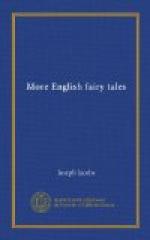For some general remarks on the English Folk-Tale and previous collectors, I must refer to the introductory observations added to the Notes and References of English Fairy Tales, in the third edition. With the present instalment the tale of English Fairy Stories that are likely to obtain currency among the young folk is complete. I do not know of more than half-a-dozen “outsiders” that deserve to rank with those included in my two volumes which, for the present, at any rate, must serve as the best substitute that can be offered for an English Grimm. I do not despair of the future. After what Miss Fison (who, as I have recently learned, was the collector of Tom Tit Tot and Cap o’ Rushes), Mrs. Balfour, and Mrs. Gomme have done in the way of collecting among the folk, we may still hope for substantial additions to our stock to be garnered by ladies from the less frequented portions of English soil. And from the United States we have every reason to expect a rich harvest to be gathered by Mr. W.W. Newell, who is collecting the English folk-tales that still remain current in New England. If his forthcoming book equals in charm, scholarship, and thoroughness his delightful Games and Songs of American Children, the Anglo-American folk-tale will be enriched indeed. A further examination of English nursery rhymes may result in some additions to our stock. I reserve these for separate treatment in which I am especially interested, owing to the relations which I surmise between the folk-tale and the cante-fable.
Meanwhile the eighty-seven tales (representing some hundred and twenty variants) in my two volumes must represent the English folk-tale as far as my diligence has been able to preserve it at this end of the nineteenth century. There is every indication that they form but a scanty survival of the whole corpus of such tales which must have existed in this country. Of the seventy European story-radicles which I have enumerated in the Folk-Lore Society’s Handbook, pp. 117-35, only forty are represented in our collection: I have little doubt that the majority of the remaining thirty or so also existed in these isles, and especially in England. If I had reckoned in the tales current in the English pale of Ireland, as well as those in Lowland Scots, there would have been even less missing. The result of my investigations confirms me in my impression that the scope of the English folk-tale should include all those current among the folk in English, no matter where spoken, in Ireland, the Lowlands, New England, or Australia. Wherever there is community of language, tales can spread, and it is more likely that tales should be preserved in those parts where English is spoken with most of dialect. Just as the Anglo-Irish Pale preserves more of the pronunciation of Shakespeare’s time, so it is probable that Anglo-Irish stories preserve best those current in Shakespeare’s time in English.




